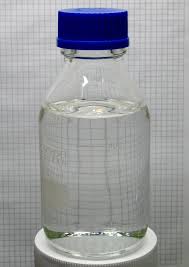Formaldehyde
What is Formaldehyde
Formaldehyde is a member of the large family of chemicals called a volatile organic compound. It is present in the gaseous state at room temperature. It is known as a gas that also dissolves in water and has a strong odor. It is a naturally occurring gas and stored as an aqueous solution (formalin). Formaldehyde is the first member of series of alphabetic aldehydes and a very reactive compound. The common name of this compound comes from its relation to formic acid. It has a wide range of applications on the industrial level.
Formaldehyde breaks within hours by sunlight or bacteria present in the soil as it does not accumulate in the environment. Human bodies made formaldehyde in the body, where enzymes break it into formic acid.
Another name of formaldehyde is methanol. Dehydration method use to synthesis formaldehyde. Its formation uses the heat obtained by burning hydrogen is used for the endothermic reaction. The oxidation process of methanol used to prepare formaldehyde; (while molybdenum and iron oxide are present as catalysts).
Formaldehyde is a non-toxic gas, but excess of anything can be fatal. The long-term presence of formaldehyde in the air can be dangerous and results in skin irritation, itching, dermatitis, and asthma, and its most hazardous form is cancer.
Formaldehyde provides a wide range of applications industry. It is a common precursor to other complex compounds and produces a whole class of different resins that use formaldehyde.
Formaldehyde produces resins like urea-formaldehyde resin, polyoxymethylene plastic, phenol-formaldehyde resin, 1,4 butanediol. The textile industry uses these resins as finishers the fabric crease-resistant. Formaldehyde has a disinfectant nature in the aqueous state; that's why people use it as a disinfectant against bacteria and fungi
USES AND APPLICATIONS FOR Formaldehyde
INDUSTRIES
It is used in numerous industrial applications like:-
- Drug testing
- Photography
- Tissues fixative
- Embalming agent
- Disinfectant
- Resin
… and many more.
Details of SNDB Chemicals Formaldehyde can be found below:-
Formaldehyde, with its chemical formula CH2O, is a versatile organic compound widely used across various industries for its diverse range of applications. As a simple but highly reactive molecule, formaldehyde plays a crucial role in numerous manufacturing processes, scientific research, and everyday products.
Chemical Properties: It is a colorless, strong-smelling gas at room temperature, but it is commonly handled and transported in solution form, typically as formalin, which is a water solution containing about 37% formaldehyde by weight. This compound is highly soluble in water and most organic solvents, making it easy to incorporate into various formulations.
Industrial Applications: It is an essential building block in the production of a wide array of industrial and consumer products. Its primary applications include:
- Resins and Adhesives: It-based resins, such as urea-formaldehyde, phenol-formaldehyde, and melamine-It, are integral components in the manufacturing of wood products, laminates, plywood, and adhesives.
- Textiles and Leather: It is used in textile finishing processes to impart wrinkle resistance, durability, and colorfastness to fabrics. Similarly, it is employed in leather tanning to improve strength and resistance to degradation.
- Plastics and Polymers:It based polymers find applications in the production of plastic materials, coatings, and synthetic fibers, contributing to the versatility and performance of these products.
- Biocides and Disinfectants: Its antimicrobial properties make it a key ingredient in disinfectants, preservatives, and biocidal formulations used in healthcare, agriculture, and industrial settings.
Laboratory and Scientific Applications: In laboratory settings, formaldehyde serves various purposes, including:
- Tissue Preservation: It-based fixatives, such as formalin, are extensively utilized for preserving biological specimens in histology and pathology laboratories.
- Chemical Synthesis: It is a vital precursor in organic synthesis, enabling the production of numerous pharmaceuticals, specialty chemicals, and fine chemicals.
- Analytical Chemistry: It is employed in analytical techniques, such as chromatography and spectrophotometry, as a derivatizing agent for detecting and quantifying certain analytes.
Health and Safety Considerations: While formaldehyde offers numerous benefits in industrial and scientific applications, it is essential to handle it with care due to its potential health hazards. Prolonged exposure to formaldehyde vapor or ingestion of formaldehyde-containing products can cause respiratory irritation, skin sensitization, and in severe cases, carcinogenic effects. Proper ventilation, personal protective equipment (PPE), and adherence to safety protocols are crucial when working with formaldehyde-containing substances.
Contact us for Details of SNDB Chemicals.




